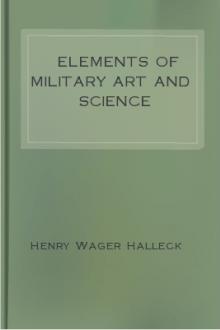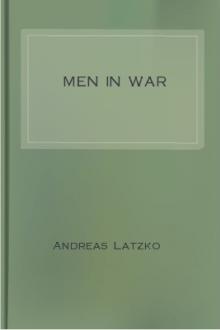Elements of Military Art and Science by Henry Wager Halleck (books you have to read txt) 📕

- Author: Henry Wager Halleck
- Performer: -
Book online «Elements of Military Art and Science by Henry Wager Halleck (books you have to read txt) 📕». Author Henry Wager Halleck
In the pursuit of Massena, in 1810, it was important to the English to cross the Guadiana, and attack the French before Badajos could be put in a state of defence. Beresford was directed by Wellington to pass this river at Jerumina, where the Portuguese had promised to furnish pontons; but they neglected to fulfil their engagement, and the army had to wait till Capt. Squire, an able and efficient officer of engineers, could construct other means for effecting a passage. Every thing was done that genius could devise and industry execute; nevertheless, the operations of the army were greatly delayed—"a delay," says the historian, "that may be considered as the principal cause of those long and bloody operations which afterwards detained Lord Wellington more than a year on the frontiers of Portugal."
We might prolong these remarks by discussing the passages of the Ceira and Alva, and their influence on the pursuit of Massena; Wellington's passage of the Tagus, and his retreat from Burgos in 1812; the passage of the Adour and Garonne in 1814; and the failure of the mines to blow up the bridges of Saltador, Alcantara, &c.; but a sufficient number of examples, it is believed, has already been adduced to show the advantage of maintaining a properly organized and instructed body of sappers, miners, and pontoniers, and the fatal results attending the want of such troops, as a component part of an army organization.
It has already been remarked that the infantry of an army must always form the basis of the apportionment; and by the general rule laid down by military writers, the cavalry should be from one-fourth to one-sixth of the infantry, according to the character of the war; the artillery about two-thirds of the cavalry, or one-seventh of the infantry; and the engineers from one-half to three-fourths of the artillery,—say about two-thirds. The staff and administrative corps must vary according to the nature of the organization, and the character of the theatre of war. The former ought to be from two to five in a thousand, and the latter from twenty-five to seventy-five,[40] as a general rule. These ratios would give for a good army organization;
Staff 5 Administrative service—pay, medical, commissary, quarter-master, etc. 65 Infantry 650 Cavalry 130 Artillery 90 Engineers 60 ======== Total 1,000In a broken country, and against savage and undisciplined foes, like the Indians in this country, the natives opposed to the English in India, to the French in Algeria, or to the Russians in Circassia, the cavalry, artillery, and engineers would be diminished, and the infantry and administrative corps proportionably increased; the former because light troops are always preferable against an undisciplined foe, and the latter because of the difficulty of moving and procuring supplies in new and uncultivated countries. The French forces in Algeria, in 1844, amounted to about sixty thousand men, in the following proportion:—
[40]
This supposes the teamsters, wagon-masters, hospital-servants, &c., to be enlisted men, and not persons hired for the occasion as is done in our army.
In small peace establishments the relative proportion of infantry and cavalry should be much less than when prepared for the field, because troops for these two arms can be much more readily formed in case of emergency, than for those which require more scientific information, and technical skill and instruction. The staff and engineers are evidently the most difficult to be formed in case of war, and next to these the artillery and administrative corps.
In this country we can maintain, in time of peace, only the framework of an army, looking to our citizen soldiery to form, in case of need, the great mass of our military force. This is the starting point in our military system, and the basis of our army organization. Let us see whether this principle is carried out in practice.
For every thousand men in our present organization[41] we have,
[41]
These numbers are the real rather than the nominal proportions, many of our officers being called staff, who properly belong to one of the other classes.
[42]
Much of the administrative duty in our army is done by unenlisted men, or by soldiers detached from their companies. Where such is the case, the ratio of this branch of the service ought to be no higher than is represented above.
We see from this table, that while our artillery is nearly six times as numerous as in ordinary armies, our staff is less by one-half, and our engineers not more than one-half what ought to be their proportion in a war establishment. To this excess of artillery over infantry and cavalry in our army in time of peace there is no objection, inasmuch as the latter could be more easily expanded in case of war than the artillery. But for a still stronger reason our staff and engineers should also be proportionally increased, instead of being vastly diminished, as is actually the case.
Experience in the first campaigns of the American Revolution strongly impressed on the mind of Washington the absolute necessity of forming a regular and systematic army organization. But so difficult was it to obtain properly instructed engineers, that he was obliged to seek his engineer officers in the ranks of foreign adventurers, and to make drafts from the other arms of service, and have them regularly instructed in the duties of engineer troops, and commanded by the officers of this corps. An order, in his own handwriting, giving the details of this temporary arrangement, is dated March 30th, 1779. Until men are enlisted for the purpose, companies of sappers and miners shall be formed by drafts from the line. "The duties of the companies of sappers and miners," he continues, "shall be under the direction of the engineers, to construct field-works of every kind, and all works necessary for the attack or defence of places, as circumstances may require. On a march in the vicinity of an enemy, a detachment of the companies of sappers and miners shall be stationed at the head of the column, directly after the vanguard, for the purpose of opening and mending the roads, and removing obstructions," &c. &c.
The great difficulties encountered by Washington in instructing his inexperienced forces in the more difficult branches of the art, made him the more earnest, in after years, to impress on us how important it was for us In peace to prepare for war. The preparation here meant is not the keeping up, in time of peace, of a large standing army, ever ready to take the field; but rather the formation of a small body, educated and practised in all the scientific and difficult parts of the profession; a body which shall serve as the cadre or framework of a large army, capable of imparting to the new and inexperienced soldiers of the republic that skill and efficiency which has been acquired by practice. How far have we accomplished this object, and what will be the probable operations in case of another contest with a European power? New and inexperienced troops will be called into the field to oppose a veteran and disciplined army. From these troops we shall expect all the bravery and energy resulting from ardent patriotism and an enthusiastic love of liberty. But we cannot here expect much discipline, military skill, or knowledge of the several branches of the military art. The peaceful habits of our citizens tend but little to the cultivation of the military character. How, then, are we to oppose the hostile force? Must human blood be substituted for skill and preparation, and dead bodies of our citizens serve as epaulements against the inroads of the enemy? To some extent, we fear it must be the case; but not entirely so, for government has not altogether neglected to make preparation for such an event. Fortifications have been planned or erected on the most important and exposed positions; military materials and munitions have been collected in the public arsenals; a military school has been organized to instruct in the military sciences; there are regularly kept up small bodies of infantry and cavalry, weak in numbers, but capable of soon making good soldiers of a population so well versed as ours is in the use of the musket and the horse; an artillery force, proportionally much larger, is also regularly maintained, with a sufficient number of men and officers to organize and make good artillery-men of citizens already partially acquainted with the use of the cannon. But an acquaintance with infantry, cavalry, and artillery duties is not the only practical knowledge requisite in war. In the practical operations of an army in the field, rivers are to be crossed, bridges suddenly erected and suddenly destroyed, field-works constructed and defended, batteries captured and destroyed; fortifications are to be put in order and defended, or to be besieged and recaptured; trenches must be opened, mines sprung, batteries established, breaches made and stormed; trous-de-loup, abattis, palisades, gabions, fascines, and numerous other military implements and machinery are to be constructed. Have our citizens a knowledge of these things, or have we provided in our military establishment for a body of men instructed and practised in this branch of the military art, and capable of imparting to an army the necessary efficiency for this service? Unfortunately this question must be answered in the negative; and it is greatly to be feared that the future historian will have to say of us, as Napier has said of the English:—"The best officers and soldiers were obliged to sacrifice themselves in a lamentable manner, to compensate for the negligence and incapacity of a government always ready to plunge the nation into a war, without the slightest care of what was necessary to obtain success. Their sieges were a succession of butcheries; because the commonest materials, and the means necessary to their art, were denied the engineers."[43]
[43]
The subjects discussed in this chapter are also treated by most authors on Military Organization and Military History, and by the several writers on Military Engineering. Allent, Vauban, Cormontaigne, Rocquancourt, Pasley, Douglas, Jones, Belmas, Napier, Gay de Vernon, may be referred to with advantage. Pasley, Douglas, Jones, and Napier, speak in the strongest terms of the importance of engineer troops in the active operations of a war, and of the absolute necessity of organizing this force in time of peace. A list of books of reference on Military Engineering will be given at the close of the following chapters.
While these pages are passing through the press, Congress has authorized the President to raise one company of engineer troops! This number is altogether too small to be of any use in time of war.
CHAPTER XIII.PERMANENT FORTIFICATIONS.
Fortification is defined,—the art of disposing the ground in such a manner as to enable a small number of troops to resist a larger army the longest time possible. If the work be placed in a position of much importance, and its materials be of a durable character, it is called permanent; if otherwise, it receives





Comments (0)